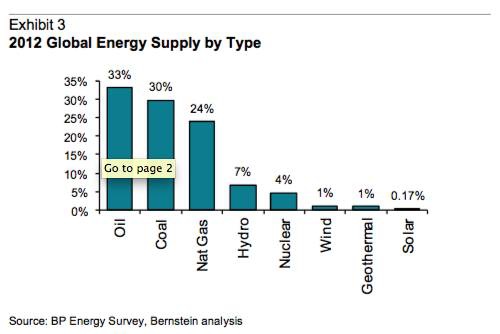
全球的能源產業總值約 5 兆美元,如今,這個巨大的產業可能將面臨天翻地覆的轉變,或至少會面臨一場嚴重的通貨緊縮──根據著名的投資銀行桑福德伯恩斯坦公司(Sanford Bernstein)的見解。
桑福德伯恩斯坦的看法當然並非空穴來風,這場大風暴將來自於太陽能,先前《科技新報》已經報導許多機構一一指出太陽能已經低於電網平價,包括德意志銀行以及德國與歐洲最大科技應用研究機構弗勞恩霍夫(Fraunhofer),但這都只是觀察現時點,若將時間拉長,看整個太陽能跌價的趨勢,那將十分觸目驚心。
桑福德伯恩斯坦畫出 1949 年以來各種能源的價格變化圖,其中太陽能過去是貴到破表,這可不只是個形容詞,而是真的貴到連表上都畫不進去的破表,一直到 2009 年才出現在表的範圍內,但接下來,太陽能的價格從破表一路雪崩式的狂降,到目前已經低於石油與亞洲的天然氣。桑福德伯恩斯坦在報告中表示,太陽能對亞洲新興國家來說,已經是「便宜、潔淨、便利、可靠的能源,而且它是一種科技,所以還會隨著時間越來越便宜」。

桑福德伯恩斯坦的看法是對的,太陽能的價格還在持續以這樣的勢頭下降,不論是薄膜太陽能的領導廠商First Solar或是晶矽太陽能的領導廠商SunPower,都提出大幅降低成本的預測。
另一方面,石化燃料的價格則會持續提升,這是因為低成本、易開採的石油來源逐漸枯竭,人類只好往較不易開採、成本越來越高的石油來源發展,導致開採成本隨著時間逐步提升。另一方面,天然氣固然因為近年來所謂頁岩氣革命而一時來到歷史低點,不過頁岩氣也無法逃脫這個定律,容易開採的頁岩層會先枯竭,之後越來越往不易開採,成本越來越高的頁岩層發展,因此,仍然會走上緩升的格局。
一來一往之間,可說太陽能將比石化燃料越來越便宜,而此一價格上的逆轉,將導致能源業的天翻地覆。這是因為目前全球能源仍以石化燃料為主,其中石油佔了 33%,煤炭佔了 30%,天然氣則佔 24%,而目前太陽能只佔 0.17%,幾乎可略,但在太陽能低於石化燃料成為趨勢與事實的情況下,這本來只有 0.17% 的太陽能,顯然將侵蝕,甚至取代石化燃料現在佔據的市場。

桑福德伯恩斯坦指出,太陽能侵蝕石化燃料市場的現象,並非未來式,而是現在就已經發生,在非洲、中東與印度鄉間等許多開發中國家的偏遠地區,原本由於沒有電力網路,居民以柴油發電機發電,或以煤油燈照明,現在改為使用太陽能與能源儲存裝置,取代過去的煤油與柴油,的的確確的減少了石化燃料的使用。
而桑福德伯恩斯坦還認為,如美國、歐洲與澳洲家戶屋頂分散式太陽能的興起,也顯然取代了許多天然氣的使用量,未來亞洲各國積極發展太陽能,也勢必降低天然氣的使用量。
桑福德伯恩斯坦更大膽預言,雖然太陽能現在於世界能源市場中所佔比率相當小,但在價格因素下,10 年內太陽能就會奪取相當大的市佔比例,大到太陽能將觸發全球能源市場價格大跌,並對石化燃料產業造成嚴重打擊。另一方面,太陽能必然的擴張,則會帶動能源儲存產業的興起,而桑福德伯恩斯坦認為,許多不適合電動車產業,因而被電動車市場淘汰的電池技術,卻可能適用於能源儲存,更可能打入分散式能源趨勢中,家家戶戶都有自有能源儲存裝置的龐大市場,進入 20 億戶家庭的後院目標是市場。
桑福德伯恩斯坦表示,未來能源價格將不再受到地理上的藏量的影響,而是由太陽能科技的進步速度所主導,能源業將進入已太陽能與能源儲存為主流的時代,這樣的未來是不可避免的,但其影響可能提早發生,因為過去石油業者會保留蘊藏量,以期望在未來賺取更多獲利,然而若預期能源價格會下跌,那麼保留存量不再是理性的選擇,業者將以最大產量生產,盡快將所有的蘊藏量換為現金,如此一來,能源價格將會提早開始崩潰。根據桑福德伯恩斯坦的見解,一場能源價格通貨緊縮,已無可避免。
Investment bank Sanford Bernstein says solar is “cheap, clean, convenient and reliable.”
Industry observers have seen many dramatic graphs about price reductions in solar recently, such as this one tracing price drops over the last 30 years andthis one from Citigroup, but the following graph from investment bank Sanford Bernstein is quite stunning -- not just for its simplicity but because it draws attention to the potential impact of solar on the $5 trillion global energy market.
As shown in the chart, the cost of solar PV has come from -- quite literally -- off the charts less than a decade ago to a point where Bernstein says solar PV is now cheaper than oil and Asian LNG (liquefied natural gas). It does its calculations on an mmbtu basis (mmbtu is the standard unit of measure for liquid fuels, often referred to as 1 million British thermal units).
“For these [developing Asian economies], solar is just cheap, clean, convenient, reliable energy. And since it is a technology, it will get even cheaper over time,” Bernstein writes in a newly released report.
“Fossil fuel extraction costs will keep rising. There is a massive global market for cheap energy, and that market is oblivious to policy changes” in China, Japan, the EU or the U.S., according to the bank.
As Bernstein notes in its report, the share of solar PV in the global energy market is currently so small that “the idea that oil and gas is the 'loser' in this formulation is laughable...in 2014,” a contention confirmed by the following chart.
But that’s not likely to be the case a decade from now. Solar is already eating away at the margins of oil and gas demand. Bernstein says the adoption of solar in off-grid areas in developing markets will translate into less demand for kerosene and diesel. The adoption of solar in the Middle East means less oil demand. The adoption of solar in China and developed Asia means less LNG demand. And distributed solar in the U.S., Europe and Australia will likely serve to reduce natural gas demand.
And then Bernstein drops this bombshell: while solar has a fractional share of the market now, within one decade, solar PV (plus battery storage) may have such a share of the market that it becomes a trigger for energy price deflation, with huge consequences for the massive fossil fuel industry that relies on continued growth.
“The behavior from here seems clear: the solar industry will expand. Retaliatory steps from distribution utilities will increase the market for cost-effective battery storage. This becomes -- initially -- a secondary market for battery technologies being developed for the auto sector. A failed battery technology in the auto sector (too hot, too heavy, too rigid a form factor) might well be perfect for the home energy storage market...with an addressable end market of 2 billion backyards.
“And for some years, that will be the extent of the effect. We have previously calculated how large the solar sector would need to be in order to become a material share of incremental energy supply each year and therefore begin to displace high-cost oil and gas supply and start to depress prices.
“We estimate that the solar industry would need to be an order of magnitude larger than it is today to have this kind of impact. At the point where solar is displacing a material share of incremental oil and gas supply, global energy deflation would become inevitable: technology (with a falling cost structure) would be driving prices in the energy space. But even on an aggressive view, this could take the better part of a decade.”
But, the Bernstein analysts say, the chief risk is that they are being too conservative. The big oil and gas producers, and the investors that control the flow of capital, may not wait until energy prices do actually deflate; they will likely change their behavior well before that in anticipation that it will happen.
“If the downward sloping forward curve is ever accepted as permanent, rational behavior from energy producers will guarantee it is so. Sitting on oil and gas reserves for the benefit of generations yet to come ceases to be a rational strategy if that reserve represents a depreciating rather than an appreciating asset.”
This, Bernstein says, is the hidden flaw with the idea that solar is “too small to matter.” Ultimately, it says, what may kill the energy market for equity investors is not the fact that renewable technology and battery storage will turn into behemoths, but the realization of that future as inevitable.
(首圖圖片來源-Flickr-Christine by-sa-small)
Solar’s Dramatic Price Plunge Could Trigger Energy Price Deflation
資料來源:科技新報



 留言列表
留言列表